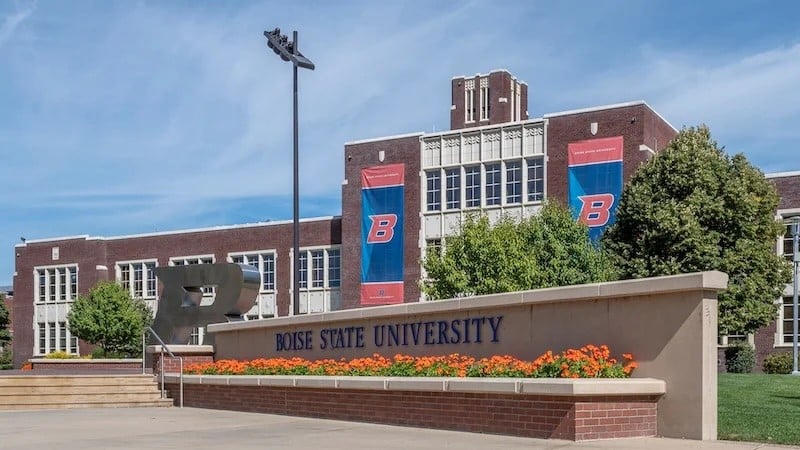Alicia Estey’s Multifaceted Approach to Leadership

Alicia Estey, Boise State University’s chief financial and operating officer and vice president for finance and operations, has built a reputation as a leader who understands the intersection of policy, higher education, and community engagement.
Estey recently announced her selection as the University of Vermont’s next Vice President for Finance and Administration, but she has been a driving force at Boise State University, playing a pivotal role in shaping initiatives that support students, strengthening university operations, and fostering partnerships beyond campus.
“Alicia has been a stabilizing force for Boise State during the past two decades. Her commitment to our students and campus community, combined with her innovative approach and strategic mindset, has better positioned the university for the future,” said Jeremiah Shinn, Boise State’s interim president.
Estey began working at Boise State in 2006, starting in a policy position. Estey’s responsibilities expanded regularly within the university. “About every two years, I seemed to take on more responsibility,” she notes. Her background allowed her to contribute to multiple university functions, from finance and operations to public health and campus safety.
Balancing the Books When Others Cannot
Higher education institutions nationwide face significant financial challenges. The University of Arizona recently discovered a $240 million budget miscalculation, turning what should have been a surplus into a $177 million deficit. This error prompted criticism from students and faculty, who raised concerns about financial oversight and transparency at the university.
Penn State University announced plans to close some branch campuses. President Neeli Bendapudi announced that while the seven largest branch campuses: Abington, Altoona, Behrend, Berks, Brandywine, Harrisburg, and Lehigh Valley will remain open, the other 12 campuses are under review for potential closure. The final decision is expected by spring commencement, with no closures occurring before the end of the 2026-27 academic year.
However, at Boise State University, under Alicia Estey’s guidance, the school eliminated a $15 million structural deficit. The achievement helped earn Estey an Idaho Business Review Excellence in Finance award.
“Throughout her career, Alicia has demonstrated unparalleled commitment and expertise in financial management, compliance, and operations,” stated Lauren Griswold, Boise State University’s chief communications and marketing officer. “Her profound understanding of the complexities of public higher education institutions has been pivotal in steering Boise State to stronger fiscal health.”
The corrective measures required difficult choices. Rather than imposing solutions from above, Estey gathered stakeholders from across the university to develop a collective response.
“I brought all of our deans and administrators together,” Estey says. The group ultimately decided on a 2.5% reduction across departments while implementing controls to prevent future deficits.
Pandemic Response Showcases Versatile Expertise
The Federal Reserve Bank of Philadelphia recently highlighted “unprecedented fiscal challenges” in higher education, exacerbated by the pandemic. Many institutions struggled to adapt when campuses shuttered nationwide in 2020, and as many as 80 colleges and universities may close over the next five years.
Estey’s background proved uniquely suited to this moment. Her master’s in public health, law degree, and business administration training equipped her to design comprehensive safety protocols when Boise State University returned to in-person instruction in the fall of 2020.
“We created a public health department which allowed us to bring about 50% of our students back to campus for face-to-face instruction,” Estey says. The university prioritized freshmen and seniors, established detailed contact tracing, de-densified classrooms, and converted a residence hall into an isolation facility.
“I felt a lot of weight on my shoulders because I was overseeing the university’s response,” she recalls. “I took that responsibility very seriously”
The comprehensive take worked; the university maintained operations without interruption throughout the remainder of the pandemic.
The Alicia Estey Approach to Collaborative Decision-Making
Estey champions transparency and relationship-building over hierarchical management. This philosophy materializes in her way of dealing with funding decisions. University vice presidents present their divisional priorities annually and then collaborate to determine the most mission-critical investments. “We can’t do everything,” Estey explains. “What are the most important things that will help us move forward and accomplish our mission?”
She pushes staff to develop solutions rather than merely identify problems. “People sometimes say, ‘Well, here, here’s the problem, can you fix it?'” Estey observes. “When they feel supported and empowered, staff are uniquely qualified to solve problems they understand best.”
Her diverse responsibilities overseeing 37 campus units with a $743 million total budget required intellectual flexibility. “It’s a really exciting job. No day is like any other day,” she says. “It never gets dull.”
While many institutions struggle with enrollment downturns, Boise State University maintains stability. “We haven’t had any enrollment declines,” Estey notes. “We’re in an area that’s growing in population. We have a solid track record and a good reputation”
The university’s financial health allows continued infrastructure investment. Current projects include a new residence hall, which is scheduled to welcome 452 first-year students in fall 2025, an expansion of the football stadium’s north end zone, and plans for a science research building.
The science facility represents Boise State University’s largest construction project yet. Estey says, “Our research portfolio is growing. Our investments are growing, and we are about to move from an R2 category to an R1, which is a very high research doctoral institution.”
These investments aim to strengthen the institution’s position amid demographic challenges. The Western Interstate Commission for Higher Education projects a 3.1% decline in high school graduates by 2030 compared to 2023 levels, with more substantial decreases predicted in subsequent years.
The financial stability Alicia Estey helped create has positioned Boise State University to navigate upcoming challenges with confidence. Her practical approach to leadership combining fiscal responsibility with community engagement has built a strong foundation to support the university’s educational goals even as higher education faces uncertain times ahead.





